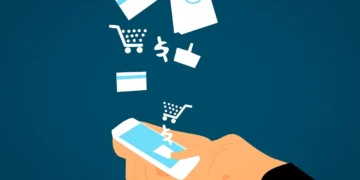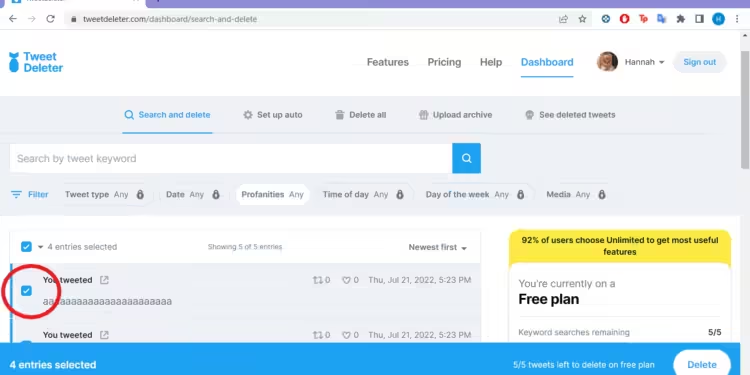Social media platforms like Twitter (X) allow users to share thoughts, opinions, news, and more in short, public posts called tweets. While tweeting can be a fun and engaging way to interact online, it also creates a public record of everything you share. This raises an important question – should you delete old tweets or keep them on your profile?
There are good arguments on both sides. Deleting tweets regularly can help curate your online persona and protect your brand. However, a long history of tweets can also demonstrate your expertise and authenticity to new followers over time. The right approach depends greatly on your goals and priorities as a Twitter user.
This article will cover everything you need to know to make an informed decision about keeping or deleting old tweets, including tools like TweetEraser to assist in the process. Key topics include:
- The risks of accumulating old tweets over time
- The benefits of maintaining a long-term tweet history
- How to evaluate your tweeting habits and priorities
- Rules for deleting or keeping tweets
- Tools to help manage and curate old tweets
By the end, you’ll have a clear framework for deciding what stays on your Twitter profile and what gets deleted. Let’s dive in!
The Risks of Accumulating Old Tweets
Most Twitter users have sent a clumsy, embarrassing, or controversial tweet at some point. And thanks to Twitter’s public and permanent nature, those tweets remain part of your profile unless you actively delete them. Here are some of the most common risks of leaving too many old tweets up over long periods of time:
Reputation Management Issues
Thoughtless tweets from your past can easily resurface years later and damage your current reputation. This is especially risky for public figures, but it applies to everyday users, too. Off-color jokes, insensitive remarks, immature opinions – what felt fine to tweet years ago can look awful to fresh eyes today.
As cancel culture and public shaming continue to grow online, more and more old tweets lead to lost jobs, partnerships, and credibility every year. Maintaining strict control over your tweet history is crucial for long-term reputation management.
Security and Privacy Concerns
The more personal information you share publicly online, the more vulnerable you become to hacking, fraud, stalking, and identity theft. While individual tweets rarely contain much private data, your entire tweet history taken together can provide hackers and bad actors an information goldmine.
Making matters worse, deleted tweets are often archived by third parties and still accessible with the right tools and know-how. The only surefire way to erase compromising tweets is never to send them at all.
Message Dilution
Over many years of casual tweeting, you may find your profile fills up with off-topic remarks, pointless observations, and outdated opinions that dilute your core message. This becomes especially problematic if you hope to use X to build a personal brand, promote a business, or establish industry expertise.
Potential partners, clients, and followers could easily tune out after wading through too many tweets unrelated to your professional goals. Pruning these distracting tweets helps keep your messaging focused.
Boring Redundancy
Humans crave novelty. If a new visitor keeps seeing similar tweets and opinions repeat across your feed, they’ll likely lose interest fast. Too many recurring hashtags, tweet formats, or pet topics also scream “bot account”. Keeping your content stream feeling fresh requires regularly removing stale tweets.
The Benefits of Maintaining Tweet History
Deleting old tweets clearly mitigates serious reputation risks. But before aggressively pruning your entire history, consider the major perks of maintaining a long, unbroken series of tweets:
Shows Authenticity
In an online landscape rife with bots, influencer marketing, and purchased followers, a years-long tweet history can differentiate authentic personal brands from “fake” ones. After scrolling back and seeing tweet after genuine tweet, visitors feel reassured that you’re the real deal.
This helps newer followers, partners, or the press understand exactly who you are and what you stand for without guessing. Of course, this benefit only applies if your archived tweets reflect your true self and priorities.
Demonstrates Expertise Over Time
Consistently tweeting quality insights on a topic for months or years establishes you as an industry expert in many follower’s eyes. Even years-old relevant tweets can capture new visitors’ interest and earn followers.
Pruning old tweets means losing valuable evidence of one’s long-term dedication and knowledge. Many Twitter experts cite their tweet history when pitching partners or demonstrating thought leadership.
Shows Your Growth
For better or worse, your tweet history tells a story about “who you used to be”. If curated intentionally, these tweets can illustrate profound personal growth in views, tone, priorities and more over the years. This level of transparency around your journey can build deep reader empathy and trust.
Of course, this benefit requires enough positive progress between old and new tweets. Large gaps without improvement can actually have the opposite effect.
How To Evaluate Your Tweeting Habits and Priorities
With compelling cases for deleting and keeping tweets, how do you decide on the right balance? Start by analyzing a few key factors:
- Your goals on Twitter – Casual tweeters and professional influencers need very different history management strategies. Those tweeting for fun face fewer risks of going tweet-crazy without deletions. However, brand builders must scrutinize how each tweet impacts their long-term messaging and credibility.
- The types of content you tweet – Tweets sharing personal life details, controversial opinions, or offensive language clearly require more caution. More innocuous tweets about hobbies, commentary on pop culture, or professional insights likely age better over time.
- How frequently you tweet – Prolific tweeters filling up their feed daily face more urgency to prune than occasional tweeters. At high volumes, damaging tweets get buried faster, but good tweets also lose impact quickly. Occasional tweeters may maintain years of history just fine.
- How comfortable you feel being “canceled” – If losing partnerships, credibility, or job offers over old tweets sounds devastating, you should lean towards deleting. Those with thick skin who feel confident weathering backlash can afford to leave more tweets up.
- How interested you are in tracking personal growth – If illustrating your personal journey matters, deleting too many old milestone tweets means losing those waypoints. But if the past you feel totally disconnected from the recent you, feel freer to remove old tweets.
Rules of Thumb for Managing Tweet History
Once you analyze your specific situation, keep these general rules of thumb in mind as you build an ongoing tweet deletion strategy:
Delete Tweets That Are:
- Factually incorrect or no longer true
- Needlessly rude, hostile, or insulting
- Overly controversial or likely to offend
- Risky overshares of private details/data
Consider Deleting Tweets That Are:
- Redundant, boring, or off-topic
- Snarky, preachy, or stand-offish
- Mindless complaints and venting
- Outdated views you’ve since abandoned
Keep Tweets That Are:
- Relevant to your brand, expertise, and interests
- Display kindness, wit, wisdom, or empathy
- Start interesting conversations and debates
- Evergreen commentary rather than current events
Also, Consider Keeping:
- A small sample of old tweets for growth tracking
- Your most liked/retweeted tweet,s if still relevant
- Tweets showcasing major life events
This framework clearly separates risky tweets from those that provide enough ongoing value to remain public. Use the suggested criteria to match your goals and guide day-to-day deletion choices.
Tools To Help Manage and Curate Old Tweets
Manually browsing years of tweets across multiple devices to prune feels overwhelming. Luckily, X management platforms make sorting and deleting old posts far easier through:
- TweetEraser – A bulk tweet deletion tool offering customizable filtering options to find and delete tweets by keywords, hashtags, and date ranges. Supports uploaded Twitter archives for deep sorting and efficient curation.
- Powerful Tweet Filters – Find tweets with specific keywords, dates, hashtags, links, mentions, etc, across your entire history to flag for review or deletion
- Bulk. Tweet Management – Delete, bookmark, or download batches of tweets at once rather than individually to save a huge amount of time.
- Tweet Analytics – See most liked, shared, and commented tweets for insight into reader reactions over time. Identify your best evergreen content to keep.
- Scheduled Deletions – Queue up certain tweets or parameters to auto-delete on a set date. It is helpful for cleaning up old event commentary, time-sensitive opinions, etc.
- Downloadable Archives – Download your full tweet history to reference when making major deletions across years of tweets. It lets you review the context most platforms miss when sorting old tweets.
- Tweet Deletion Calendar – Schedule automatic periodic tweet deletions. Example: Auto-delete tweets over 2 years monthly. It keeps history long but manageable.
- Cross-Platform Posting – Sync across accounts to delete tweets from multiple profiles at once. It is helpful for monitoring personal and professional accounts in tandem.
With the right Twitter manager, you can prune years of old tweets down to the most valuable gems in hours versus weeks of tedious manual screening and clicking.
Key Takeaways: To Delete or Not to Delete Old Tweets
- Accumulating years of public tweets carries rising reputation risks in today’s judgmental online climate. However, deleting all old tweets also reduces authenticity and the benefits of expertise.
- Take a nuanced approach by analyzing your specific goals, tweet habits, and risk tolerance to decide what tweets to prune and what to keep.
- Focus deletions on tweets that are factually incorrect, offensive, redundant, or risky overshares. Keep quality tweets that demonstrate expertise, personal growth, and engaging commentary.
- Leverage Twitter management platforms to sort through years of old tweets efficiently using filters and analytics. Schedule automated deletions to maintain an optimal history length.
The debate between deleting tweets and maintaining tweet history likely won’t get easier over time. But by understanding the key tradeoffs and optimizing based on your specific situation, you can find the right balance for managing past tweets while still tweeting confidently long into the future.







































